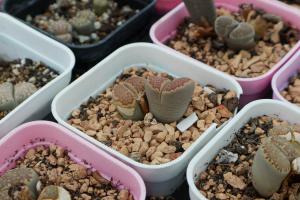Do Potted Succulent Plants Die from Too Much Water?
Succulents are a popular choice among houseplant enthusiasts due to their unique appearance and low maintenance requirements. These plants have adapted to surviving in arid environments and can store water in their leaves, stems and roots. However, even succulents can suffer from overwatering, which can lead to root rot and other problems.
Signs of Overwatering
If you suspect that your succulent is getting too much water, there are several signs to watch out for. The first indication is yellow or brown leaves that are soft to the touch. Overwatering can cause the roots to become waterlogged, which can prevent them from absorbing nutrients and oxygen from the soil. This lack of nutrients can cause the leaves to turn yellow or brown and eventually fall off.
Another sign of overwatering is mushy or blackened roots. When the roots of a succulent are exposed to too much water, they can begin to decay, turning mushy and black. This can be a death sentence for the plant, as it will no longer be able to absorb water or nutrients from the soil.
Preventing Overwatering
The best way to prevent overwatering is to allow the soil to dry out completely between waterings. It is also important to use a well-draining soil mix that allows excess water to drain away from the roots. If your succulent is planted in a container without drainage holes, it is more likely to suffer from overwatering. It is recommended to repot the plant in a container with drainage holes to improve water management.
Succulents also prefer bright, indirect light and warm temperatures. When these conditions are met, the plant will use water more efficiently and be less susceptible to overwatering. Be sure to keep your succulent away from drafty windows or air conditioning units, as this can cause the plant to dry out too quickly.
What to Do if Your Succulent is Overwatered
If you suspect that your succulent has been overwatered, the first step is to stop watering it immediately. Allow the soil to dry out completely before watering it again. It may also be necessary to trim any yellow or brown leaves or roots to prevent further damage.
If the plant is severely damaged, it may be necessary to completely repot it in fresh soil. Gently remove the plant from its container and separate any rotted or damaged roots. Allow the plant to dry out completely before repotting it in fresh soil.
Conclusion
While succulents are known for their drought tolerance, they can still suffer from overwatering. Signs of overwatering include yellow or brown leaves, mushy roots, and a lack of growth. Preventing overwatering involves allowing the soil to dry out completely between waterings, using a well-draining soil mix, and providing the plant with the right amount of light and warmth. If your succulent is overwatered, it is important to stop watering it immediately and allow it to dry out completely before taking any further action.

 how many times do yo...
how many times do yo... how many planted tre...
how many planted tre... how many pine trees ...
how many pine trees ... how many pecan trees...
how many pecan trees... how many plants comp...
how many plants comp... how many plants can ...
how many plants can ... how many plants and ...
how many plants and ... how many pepper plan...
how many pepper plan...




























